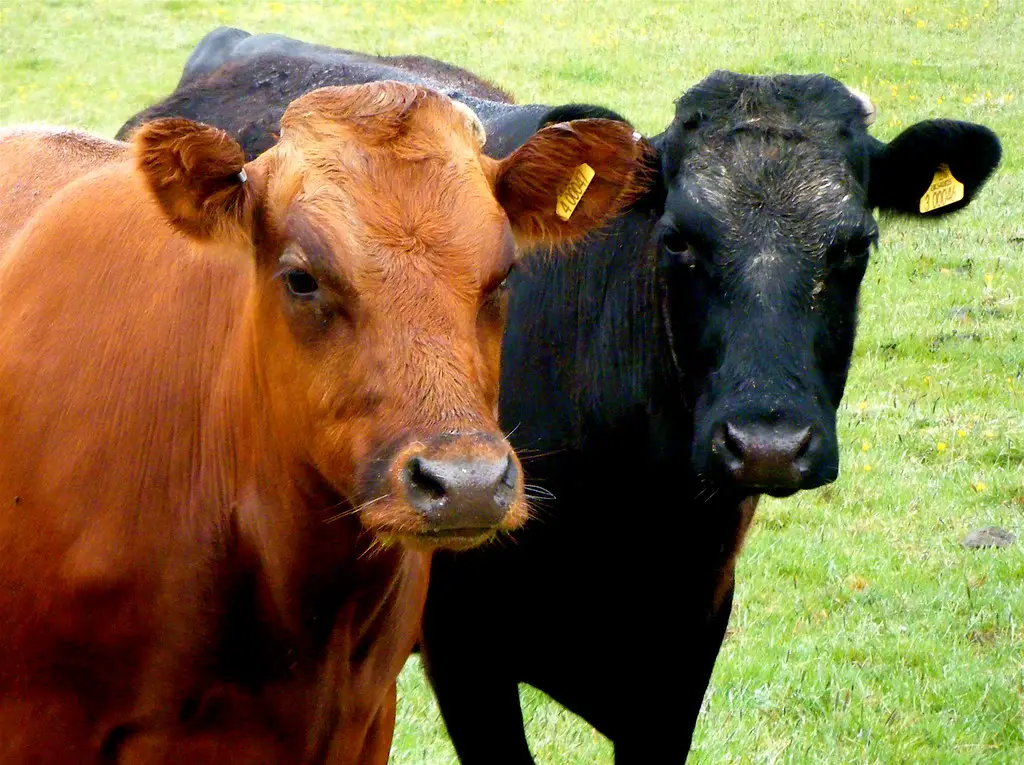
If you’re looking for a cattle breed with a rich history, a gentle nature, and the ability to thrive in different environments, then you should meet the Shorthorn. Shorthorns are one of the world’s oldest cattle breeds, and they’ve played a vital role in shaping the modern cattle industry. Let’s dive into their history, traits, and the reasons why (or why not) they might be the perfect addition to your farm.
Origin
The story of Shorthorn cattle begins in the northeastern counties of England centuries ago. Local Teeswater cattle were selectively bred over time, leading to the development of the Shorthorn breed we know today. These cattle were originally dual-purpose, valued for both milk and beef. However, over time they diverged into specialized beef and milking lines.
Characteristics
Shorthorns are a visually striking breed. You’ll see them in classic cattle colors: red, white, or a blend of the two called roan. They are moderately sized and come in both polled (naturally hornless) and horned varieties. Shorthorns are best known for their calm temperament, making them easier to handle compared to some other breeds. Another notable attribute is their early maturity, which is a plus for beef producers.

Shorthorn Cattle: Pros
Let’s talk about why Shorthorn cattle have a long and loyal following among farmers:
- Beef Powerhouse: Shorthorns bring serious value to beef production. They produce exceptionally flavorful meat with excellent marbling.
- Maternal Excellence: Shorthorn cows are fantastic mothers. They are known for easy calving and strong maternal instincts to care for their newborns.
- Adaptability Champions: Whether you’re battling harsh winters or hot summers, Shorthorns can handle it. They are surprisingly adaptable to diverse climates.
- Gentle Giants: Working with Shorthorns is generally a breeze thanks to their docile nature.
Shorthorn Cattle: Cons
It’s important to get the full picture, so let’s discuss some potential considerations to keep in mind:
- Milk Specialists: While Shorthorns have good milk production capabilities, specialized dairy breeds like Holsteins will outpace them in sheer volume.
- Growth Variations: Breeding lines that emphasize milking or maternal traits may have slightly slower growth compared to lines focused purely on beef. This means it’s important to be clear about your priorities when selecting Shorthorn genetics.
Pro Tip: It’s crucial to source your Shorthorn cattle from reputable breeders who align with your specific goals – whether you prioritize beef, milk, or dual-purpose traits.
Characteristics Table
| Trait | Description | Notes |
|---|---|---|
| Color | Red, white, or a mix of the two called roan | Blue roan variation also exists |
| Size | Moderate | Typically smaller than specialized beef breeds |
| Temperament | Docile and easy to handle | One of their most desirable traits |
| Maturity | Early maturing | Benefit for beef production |
| Milk Production | Good, particularly in Milking Shorthorn lines | Less volume than specialized dairy breeds |
| Beef Production | Excellent marbling and flavor | Highly sought-after quality |
| Adaptability | Thrive in various climates | Suitable for diverse environments |
| Horn Status | Both polled (naturally hornless) and horned varieties exist |
Milking Shorthorn Cattle
While many people think of Shorthorns as beef cattle, did you know there are dedicated Milking Shorthorn lines? These maintain a respectable beef quality while excelling in milk production, striking a nice balance for some farmers.

Absolutely, let’s continue!
Blue Roan Shorthorn Cattle
Blue roan Shorthorns are a sight to behold, sporting a unique bluish-gray coat with a mix of red and white hairs. This striking coloration isn’t a separate breed, but rather a result of specific genetics. If you’re drawn to eye-catching cattle, a blue roan Shorthorn will certainly stand out!
FAQ
Let’s answer some common questions about Shorthorn cattle:
- What are Shorthorn cattle best known for?
- Shorthorns are renowned for their versatility (beef and milk), adaptability, and their gentle nature.
- Are Shorthorn cattle good for beef?
- Absolutely! Shorthorns produce high-quality beef with exceptional taste and marbling.
- What are the cons of Shorthorn cattle?
- Some breeding lines may have slightly less milk production or growth potential compared to highly specialized breeds.
- What is another name for a Shorthorn cow?
- You may come across Shorthorn cows referred to as Durham cattle, which is their historic name.
- What breeds make a Shorthorn?
- The Shorthorn breed originated from local Teeswater cattle in England through selective breeding.
- Are Shorthorn cattle aggressive?
- No, in fact, Shorthorns are prized for their calm and docile personalities.

Conclusion
Shorthorn cattle truly are a remarkable breed with a lot to offer. If you’re looking for cattle that are adaptable, easy-going, and bring value to the table, the Shorthorn should be on your shortlist. Their history, versatility, and appealing characteristics make them a favorite among farmers worldwide.
Have you had any experience with Shorthorn cattle? I’d love to hear your thoughts and stories! Please drop a comment and share what you find most appealing about this breed.
